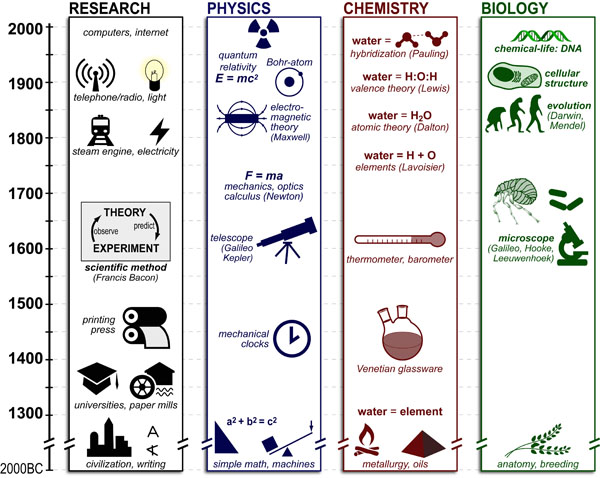Science, as we now think of it, only really started about 400 years ago when Francis Bacon unified theory, observation, and experiment in his: “A New Method.” Before this “unified procedure,” science was a patchwork of “lucky guesses” which over-emphasized one tool or another (For example, Aristotle loved reason and hated mathematics whereas Pythagoras believed the world could only be described by pure mathematics).
In addition, quantitative experimentation and the idea of “testing a hypothesis,” only really became practically feasible with inventions of the early Renaissance. Below we give more detail on some these key milestones in the advancement of research, physics, chemistry and biology.
RESEARCH:
- Civilization, Writing: The most basic pre-requisite for science is an organized society which allows/requires an “intellectual class” in order to function (e.g. basic arithmetic and writing are required for basic trading and taxes)
- Universities, Paper Mills: Science didn’t advance much from 300 BC to 1300 AD for several reasons including Roman distaste for philosophy, academic focus on theology, etc. However, the establishment of the first universities, in the early 13th century, set the foundation for later innovations of the Renaissance by enabling communication and collaboration between a growing number of “intellectual aristocrats.”
- Printing Press: The invention of the printing press in the mid-15th century enabled the first truly wide-spread dissemination of scientific publications
- Scientific Method: Francis Bacon’s “A New Method” established a new unified philosophy for the advancement of science
- Steam Engine/Electricity, Telephone/Radio/Light, Computers/Internet: Further technical innovations which directly enabled communication between scientists and increasingly precise experimentation.
PHYSICS:
- Simple Math, Machines: Greece, in particular, set much of the ancient foundation of physics in the form of qualitative mechanical principles and basic mathematical theories
- Mechanical Clocks: Quantitative study of mechanics only became possible with methods to reproducibly measure time.
- Telescope: The invention of the telescope not only birthed modern astronomy, but also set the foundation for Newton’s laws of mechanics and gravity through quantification of planetary orbits.
- Mechanics/Optics/Gravity: Isaac Newton unified and quantitatively defined mechanics, gravity and optics through rigorous experimentation and the invention of calculus.
- Electromagnetic Theory: The unification of electronic and magnetic forces by Maxwell’s equations set the foundation for electrical engineering and virtually every analytical tool later used by physicists, chemists and biologists (e.g. computers, spectroscopy, electrophoresis, etc.)
- Bohr Atom, Relativity, Quantum Mechanics: Early studies on the structure and behavior of atoms began a revolution in physics that produced: quantum theory, relativity, nuclear power, digital computers and quantitative chemistry
CHEMISTRY:
- Metallury, Oils: Early chemistry was a patchwork of metallurgy, oil extraction (pioneered by the Egyptians for embalming) and Aristotle’s ideas (e.g. water is an element).
- Venetian glassware, thermometer/barometer: Most early chemistry relied on the ability to manipulate and dissect gasses while measuring pressure, temperature and weight. All of this relied on specialized glassware developed by Venetian glass-makers during the 13th through 16th centuries
- Elements: Antoine Lavoisier, Robert Boyle and Jöns Jacob Berzelius defined the first true elements by showing that things like air and water could be decomposed into simpler substances.
- Atomic Theory: John Dalton went further to show that compounds were made up of integer ratios of elements which lead to his atomic theory of chemistry.
- Valence Theory: Later chemists, such as Gilbert Lewis built off of this atomic theory by proposing that chemical bonds could be pairs of shared electrons
- Hybridization: Finally, chemists like Linus Pauling, built up a quantum mechanical view of chemical bonds and chemical properties which is the basis of how chemists understand chemistry today.
BIOLOGY:
- Anatomy, Breeding: The foundations of modern biology were driven by very practical and primal innovations such as the domestication of animals (50-20,000BC), early agriculture (8,000 BC) and surgery/anatomy (200 AD).
- Microscope: The invention of the microscope by Galileo (and refined by Robert Hooke and Antonie Philips van Leeuwenhoek) opened up the microscopic world showing that it followed similar rules as the macroscopic world.
- Evolution: Darwin’s “On the Origin of Species” provided the first organized framework for a physical law underlying “Life”
- Cellular Structure: Synthetic dyes, developed by German chemists in the mid-1800’s, enabled the first quantitative study of the structures and processes that underlied cellular life.
- Chemical Life: Chemistry and Biology were unified in the first half of the 20th century through the demonstration that all life consisted of chemical building blocks and chemical and mechanical processes.
REFERENCES:
- Mlodinow, L. The Upright Thinkers, 2015, Pantheon Books
- McBride, J.M. Yale Chem 125: Freshman Organic Chemistry
- Forest, J.J.F.; Altbach, P.G. International Handbook of Higher Education, 2006, Springer
- Bolter, J.D. Writing Space: The Computer, Hypertext and the History of Writing, 1991, Lawrence Erlbaum Associates
- Cajori, F. A History of Physics in its Elementary Branches, 1916, The MacMillan Company
- Brush, S.B. The Role of History in the Teaching of Phyiscs, The Physics Teacher, 1969, 7, 271.
- Rasmussen, S.C. Advances in 13th Century Glass Manufacturing and their effect on Chemical Progress, Bull. Hist. Chem., 2008, 33, 28.
- Hager, T. Force of Nature: The Life of Linus Pauling, 1995, Simon & Schuster.
- Smith, T.F.; Morowitz, H.J. Between History and Physics J. Mol. Evol. 1982, 18, 265-282.
- Milestones in Microscopy, Nature Milestones, 2009, S6-S22, Macmillan Publishers Limited.

This work by Eugene Douglass and Chad Miller is licensed under a Creative Commons Attribution-NonCommercial-ShareAlike 3.0 Unported License.

